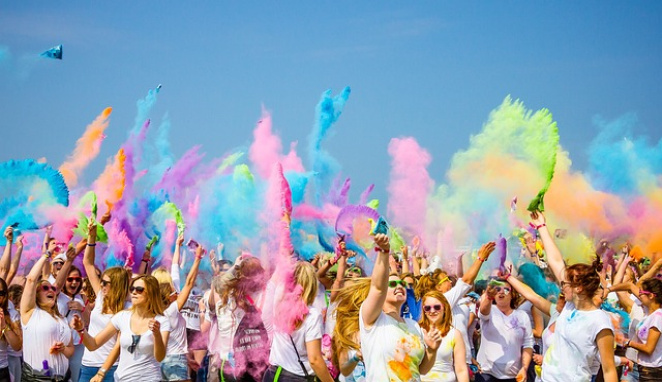Holi festival
Posted in: Spring
History of Holi
Holi, also known as the Festival of Colors, is a famous Hindu spring festival celebrated mainly in India, Nepal and other Hindu communities around the world. The festival falls annually in spring, on the last full moon of the month of Phalguna in the Indian calendar, which falls in March in the Gregorian calendar. Holi is a joyful, colorful festival that celebrates the arrival of spring, the victory of good over evil, and the unity of the community.
 The origins of Holi are rooted in Indian mythology, and there are several legends that explain the origin of the festival.
The origins of Holi are rooted in Indian mythology, and there are several legends that explain the origin of the festival.
The story of Hiranyakashipu and Prahlad: According to one of the most famous stories, Hiranyakashipu, a demon king who wanted to achieve immortality, exercised violent rule over the world. He was one of the most evil beings and wanted to kill his son Prahlad because he remained loyal to the god Vishnu, whom Hiranyakashipu hated. The king tried to use his sister Holika, who could not burn fire, to kill the boy with a spell. According to the story, after Holika sat in a fire with Prahlad, the boy was protected by God, while Holika was burned to ashes. The festival of Holi thus symbolizes the victory of good over evil, and commemorates the burning of Holika.
The Story of Radha and Krishna: According to another legend, Krishna, the Hindu god, who was dark-skinned, was afraid that the beautiful Radha, whom he loved, would not accept him because of his skin. For her sake, they started the festival of spring colors and flowers, to joyfully scatter colors, thus expressing their love and joy. This festival has thus become a symbol of love, friendship and acceptance.
Holi Customs and Traditions:
The Holi festival lasts for several days and encompasses many different traditions:
Holika Dahan: On the eve of the festival, a ceremony known as Holika Dahan is held. People light large bonfires to commemorate the burning of Holika and thus drive away evil spirits. On this evening, families and friends gather and sing and dance while praying for good luck by the fire.
Colored powder: The next day begins Holi itself, which is a celebration of colors. People throw different colored powders (gulal) at each other to express their joy and the arrival of spring. People play in the streets, parks, courtyards of houses, and everyone participates in the joyful explosion of colors, regardless of their social status, religion or age.
Music and dance: Music and dance are also an essential part of the celebration on the day of Holi. In addition to traditional Indian music, modern pop and Bollywood hits are also played in many places, so everyone can dance.
Holi and community: Holi is also a celebration of togetherness and community experience. People greet each other while throwing colored powder at each other and giving gifts. The event promotes love, respect and friendship for each other.
 Why is Holi celebrated?
Why is Holi celebrated?
The arrival of spring: Holi symbolizes the beginning of spring, when nature revives and the earth is covered with colorful flowers. Therefore, people also celebrate spring with colors, which is a time of renewal and fertility.
The victory of good over evil: Holi also reminds us that good, love and truth always triumph over evil. The fires, colored powders and joint celebration all symbolize victory.
Celebrating friendship and love: People forget their grievances and differences on this day and approach each other with love and joy. Holi is thus a symbol of forgiveness and togetherness. Celebrating fertility and new beginnings: Spring is a time of fertility, growth, and Holi is a symbol of new beginnings, growth, and flowering.
Holi around the world:
Although Holi is most prevalent in India and Nepal, the festival is widespread around the world, especially in countries with large Hindu communities. Holi is also increasingly celebrated in the United States, Canada, the United Kingdom, and other Western countries, especially by Hindu communities and people who love Indian culture. Here, it is often known as the “Holi festival of colors” and is often held as a large open-air festival where people dance, play music, and throw colored powder at each other.
Important Note
Holi color powders are made from natural materials such as flowers, herbs and other organic ingredients, but industrially produced paints containing chemicals can be harmful to health. Organic Holi powders therefore also pay attention to sustainability and safety.
So that's the history, customs and meaning of the Holi festival! A colorful, happy and unifying event celebrated in many parts of the world.